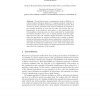Free Online Productivity Tools
i2Speak
i2Symbol
i2OCR
iTex2Img
iWeb2Print
iWeb2Shot
i2Type
iPdf2Split
iPdf2Merge
i2Bopomofo
i2Arabic
i2Style
i2Image
i2PDF
iLatex2Rtf
Sci2ools
ICANN
2007
Springer
2007
Springer
Selection of Decision Stumps in Bagging Ensembles
Abstract. This article presents a comprehensive study of different ensemble pruning techniques applied to a bagging ensemble composed of decision stumps. Six different ensemble pruning methods are tested. Four of these are greedy strategies based on first reordering the elements of the ensemble according to some rule that takes into account the complementarity of the predictors with respect to the classification task. Subensembles of increasing size are then constructed by incorporating the ordered classifiers one by one. A halting criterion stops the aggregation process before the complete original ensemble is recovered. The other two approaches are selection techniques that attempt to identify optimal subensembles using either genetic algorithms or semidefinite programming. Experiments performed on 24 benchmark classification tasks show that the selection of a small subset (≈ 10−15%) of the original pool of stumps generated with bagging can significantly increase the accu...
Related Content
| Added | 08 Jun 2010 |
| Updated | 08 Jun 2010 |
| Type | Conference |
| Year | 2007 |
| Where | ICANN |
| Authors | Gonzalo Martínez-Muñoz, Daniel Hernández-Lobato, Alberto Suárez |
Comments (0)

